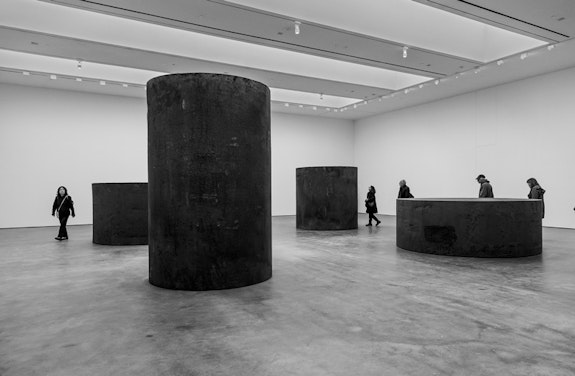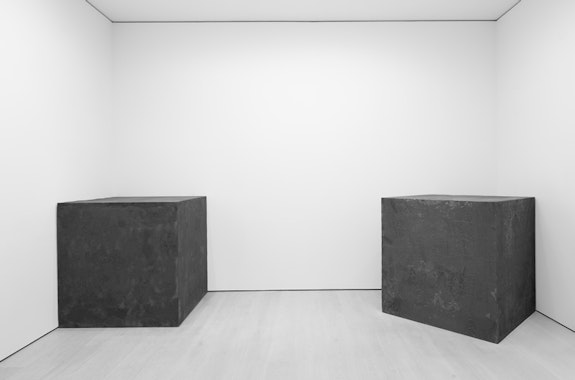ArtSeen
RICHARD SERRA:
Sculpture and Drawings
Richard Serra, Four Rounds: Equal Weight, Unequal Measure, 2017. Installation view, Richard Serra: Sculpture and Drawings, David Zwirner, New York, 2017. Photo by Cristiano Mascaro. © 2017 Richard Serra / Artists Rights Society (ARS), New York. Courtesy David Zwirner, New York/London.
The works that make up Richard Serra’s current show at David Zwirner reveal an approachability that’s surprising for a figure commonly associated with aggressive, even overwhelming, effects. The sculptures and drawings on display, all produced in the last two years, work according to a human sense of scale, and propose immediate relationships between the visitor and the exhibition space. Although they don’t dominate their environment the way many of Serra’s projects do, these recent offerings sacrifice little of the artist’s usual intensity. Instead, they condense and distill it.
New York
David ZwirnerNovember 4 – December 16, 2017
The first floor of Zwirner’s exhibition is given over entirely to two works in forged steel. The process of forging metal—as opposed to casting or rolling it, both techniques Serra has used regularly—involves exerting intense pressure from all sides, and is best used to produce solid, compact forms. Appropriately, since he adopted this method in the late 1970s, Serra’s work in forged steel has focused on elementary geometric volumes like the cylinders and cubes that make up Four Rounds: Equal Weight, Unequal Measure (2017) in Zwirner’s main gallery, and Into and Across (2017) down the hall. Unlike the expansively curved sheets of steel that Serra has used for various immersive site-specific installations, the simple forms of his forged sculptures can be comfortably circumambulated or visually understood at a glance.
This is not to say, however, that Serra’s forged works don’t have an environmental effect. The steel cylinders of Four Rounds control circulation through the gallery space, and clearly respond to the conditions of their display. The smallest cylinder, standing not quite four feet tall, is somewhat shorter than the average gallery visitor. The other three increase in height: each is about two feet taller than the last, with the largest reaching ten feet. The sculptural ensemble marks out the difference in scale between its viewers and the space of its display: Zwirner’s main gallery is expansive, with deep sawtooth skylights making it feel even taller.
Into and Across is composed of two steel cubes that measure five feet on a side. Tony Smith’s seminal Die (1968) is an obvious point of reference, and although Smith’s iconic Minimalist work is well known for activating the space that surrounds it, Serra’s cubes are yet more explicit in their address to the gallery. Both cubes are pushed into the corners of the room, recalling Serra’s use of architecture as an ad hoc casting mold. One cube is set flush with the walls, its geometric regularity highlighting the sculpture’s formal congruence with the room it occupies, while the other is rotated forty-five degrees so that it spans the distance between converging walls. Although a visitor can’t move around or between the sculpture’s units with much freedom, the work nonetheless engenders acute awareness of the space in which it is encountered.
The drawings in Zwirner’s second floor galleries, like all of Serra’s drawings, are a rich, heavy black. They make use of etching ink, silica, and Serra’s beloved paint-stick, which he has employed extensively since the 1970s. Some of the drawings are dominated by roughly quadrilateral forms, but most feature linear marks arranged horizontally or vertically, either in dense masses or almost diaphanous in their dispersal. All these works are moderate in size. Certainly, none rival the monumentality of, for example, Serra’s 1974 paint-stick masterpiece Abstract Slavery. They operate, like the forged sculptures downstairs, on a human scale, and their surfaces, although textured, do not approach the extraordinary, almost threatening, impasto Serra has sometimes favored. Instead, the black medium seems to soak deep into the paper.
This stain effect is the result of Serra’s studio procedure, adopted only over the last few years. Rather than building up layers of paintstick by hand, Serra covers a table with pigment, lays down a sheet of paper, and presses the back of the page with a metal block or a round-tipped rod. This pressure alone produces the image, and is felt palpably in the completed work. Black spreads from the sites of Serra’s intervention, which are often marked by a groove or trough scoring the paper. These visible traces of exerted force give the drawings an uneasy power. Like the intense pressures involved in manufacturing Serra’s forged sculptures, the physical pressure applied to his recent drawings reflects a concentrated and controlled energy. This intensity suffuses the entire exhibition.




